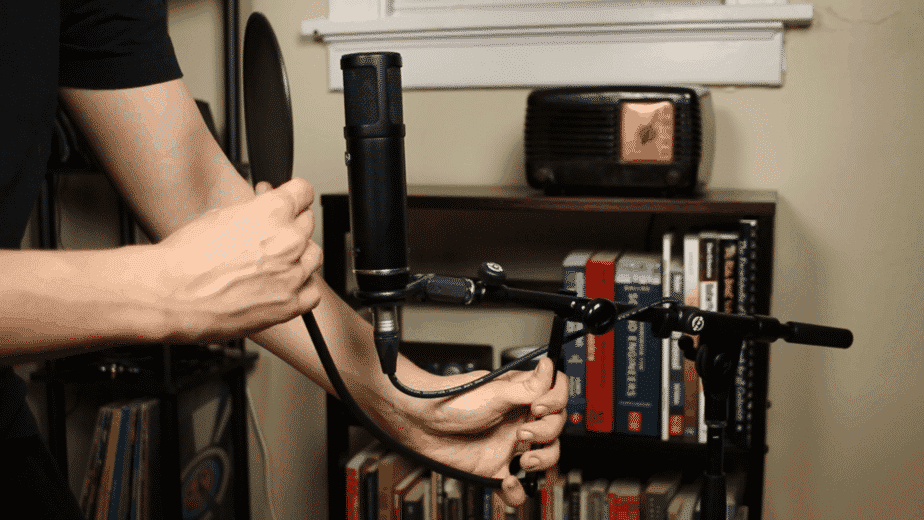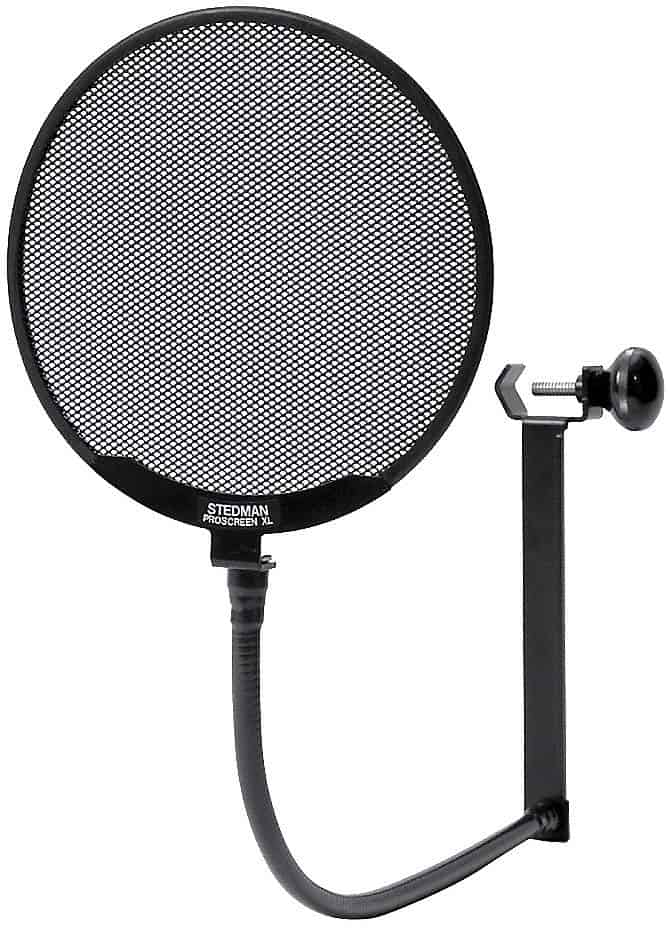When I was younger and more hesitant to pay the extra money to invest in high-quality recording equipment, I remember wondering if there was really a difference between metal and nylon mesh microphone pop filters. I have since experimented to compare metal types to mesh types and expensive models to inexpensive models.
In this article, you’ll learn 5 differences between metal and nylon pop filters with audio and video examples.
If you are trying to decide which pop filter to choose, I put this list together of the best pop filters for any budget. It includes a comparison of pop filters in the $10, $30, and $70 price range. You might be surprised by the results!
1. Nylon vs Metal Pop Filter: Method
Metal and nylon mesh pop filters work toward a common goal – to protect microphone diaphragms from the noise created by gusts of air from a person speaking a plosive sound, such as “B”, “P”, or “T”.
Metal and fabric pop filters share a common goal. However, they accomplish this goal using different methods.
Nylon Mesh Pop Filter Method
Nylon mesh pop filters diffuse air in an attempt to slow it down before it interacts with the microphone diaphragm.
This is accomplished using two thin layers of nylon as a barrier between the person speaking and the microphone. The gust of breath is resisted by the nylon fabric, reducing the level of the noise caused by plosive sounds.
You can see in this image that the gust of air is obstructed and diffused into different directions.

Metal Pop Filter Method
Metal pop filters do not attempt to diffuse or resist the air, but to instead to redirect it away from the microphone diaphragm.
As air encounters the metal mesh barrier between the person speaking and the microphone, it is redirected, or deflected, downward. If used properly, the noise caused by plosives will be greatly reduced.
This image shows the path the air takes when passed through a metal pop filter.

Watch this video that helps to visualize the metal and mesh pop filters’ methods:
2. Nylon vs Metal Pop Filter: Sound
Although two methods are used by mesh and metal pop filters, both effectively reduce noise caused by plosives. Listen to the following examples to hear the difference for yourself.
Nylon Mesh Pop Filter Sound
Nylon mesh pop filters are very effective in preventing noise from reasonable plosive sounds. Here is an audio example comparing a mesh pop filter to no pop filter.
This test was done using this Sterling Audio pop filter . It’s a good choice for those on a budget.
Metal Mesh Pop Filter Sound
Metal mesh pop filters will also prevent noises caused by plosives very well. Here is an audio example comparing a metal pop filter to no pop filter.
This test was done using this Stedman Proscreen XL pop filter in a higher price range. This is my number one choice if you are willing to invest in quality.
3. Nylon vs Metal Pop Filter: Quality
Nylon pop filters are often very inexpensive, while metal pop filters are available starting in the mid-pricerange. This difference in price often brings with it an inherent difference in quality – not just the quality of the pop filter, but also the build quality of the hardware, such as the gooseneck and clamp.
Both types are very effective. For normal purposes, either type will do the job. The main difference that I have found between metal and fabric pop filters is not in their ability to reduce plosives, but in more practical details such as build quality.
This also goes for the build quality of your microphone stand. If you’re also shopping for a reliable mic stand, read this post I wrote about K&M microphone stands. I’ve used them for years and they’re the only mic stands I buy.
Gooseneck Quality
You’ll want to ensure that the gooseneck that comes with your pop filter is flexible enough to be placed correctly.
Also make sure that the gooseneck is strong enough to hold the filter in place. Inexpensive pop filters tend to come with inexpensive goosenecks which make it difficult to properly place your pop filter.

Clamp Quality
The clamps that attach pop filters to microphone stands also vary in quality. A well-made pop filter will easily and securely fit to a variety of stands.
The build quality of the hardware will determine the longevity of the pop filter. Cheaper options may work well in the beginning but start to slip over time.

4. Nylon vs Metal Pop Filter: Visibility
Metal pop filters are much more transparent than nylon types. If the person speaking into the microphone will be reading off of a script or sheet music, a metal pop filter will make things much easier.
It is often difficult to see notes or music while maintaining a proper mic technique when using a nylon pop filter. Metal pop filters allow for a better experience because they do not obstruct the view as severely. Take a look at the difference between nylon (left) and metal (right) pop filters:

5. Nylon vs Metal Pop Filter: Maintenance
Finally, metal pop filters are also much easier to clean.
Pop filters not only protect your microphone from gusts of air, but also from saliva. Over time, saliva will build up on the pop filter, perhaps creating an odor.
A metal pop filter can be easily rinsed in the sink for cleaning. Nylon pop filters, on the other hand, are much more difficult to clean. After a while, you may find that you need to replace your nylon pop filter.
In addition to ease of cleaning, metal pop filters are also much more robust and resilient to damage.
It is easy to tear a nylon mesh pop filter if you are not careful. Once a nylon filter is torn, it will no longer be effective for reducing plosives. Metal types are more rugged and will withstand the test of time.
Which Pop Filter Should You Buy?
I believe a metal pop filter is worth the money. It will last longer and also looks and feels much more professional. However, if you are on a budget, it is alright to go with an inexpensive nylon model. The sound quality will be greatly improved by either type.
I recommend reading an article I wrote on Audio University, called Best Pop Filters for Any Budget.
If you have the budget to spend just a little more for a metal pop filter, a metal pop filter like the Stedman Proscreen XL will likely last long enough to justify the investment over time.
Even this very inexpensive nylon pop filter by Sterling Audio will remove almost all plosives from your audio recordings. It has good ratings on Amazon and is from a reputable brand.
These are the items from each category that I would recommend if you are buying a pop filter.
Metal Pop Filter: Stedman Proscreen XL
The Stedman Proscreen XL is the pop filter that I use, and it works really well for me. It is an affordable, high-quality option. The gooseneck and clamp feel very rugged and I expect mine to last a very long time.
To learn more, read this article I wrote about the Stedman Proscreen XL.

Nylon Mesh Pop Filter: Sterling Audio STPF2
If you are working on a budget, your money can be spent on more important equipment for your recording system. I would recommend using this Sterling Audio pop filter to get started. It is very inexpensive and has great reviews on Amazon.

How To Use a Pop Filter
Once you decide which pop filter to use, you might need help with how to properly install it on your microphone. You can learn how to properly place a pop filter in the following video.
